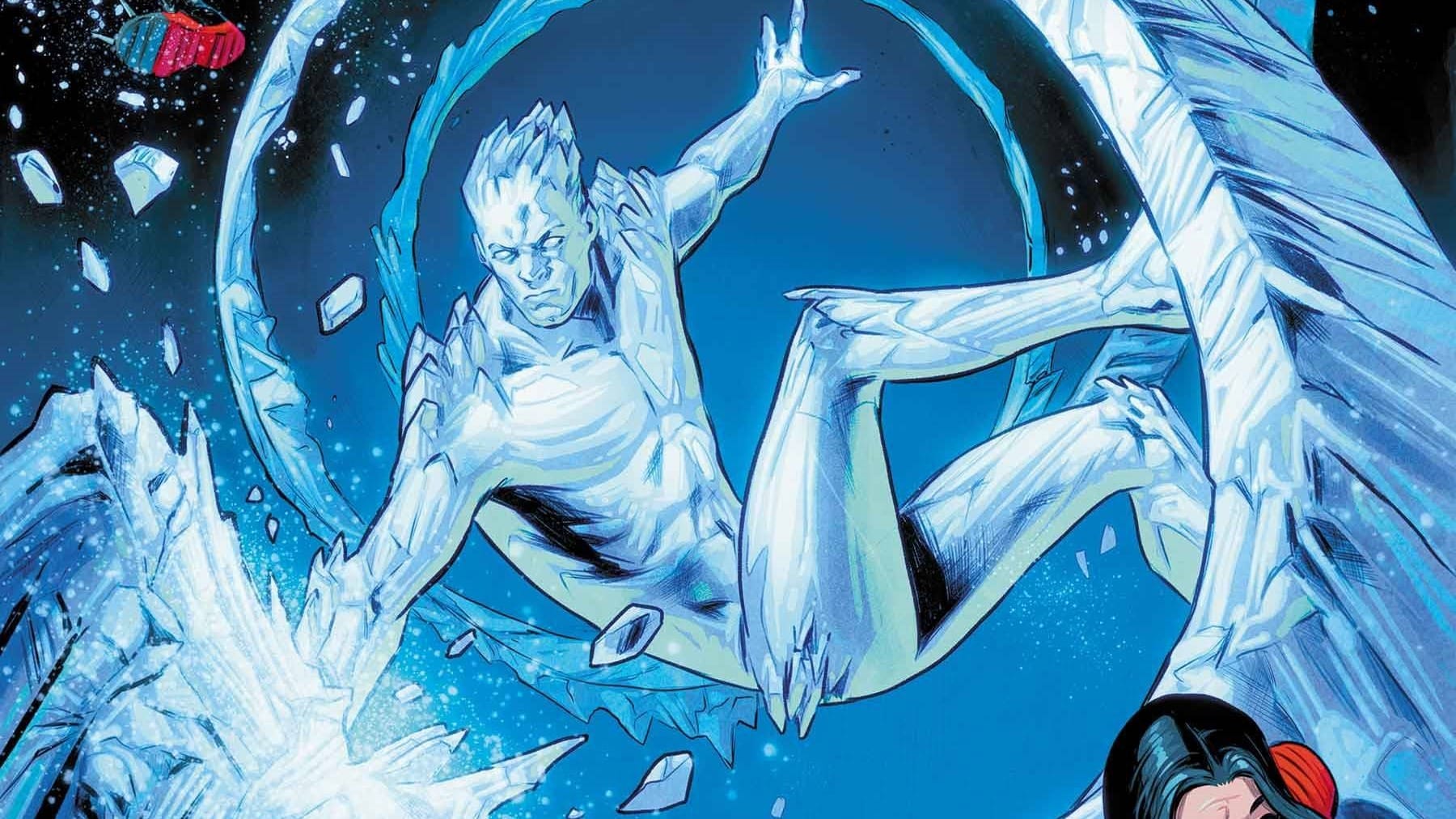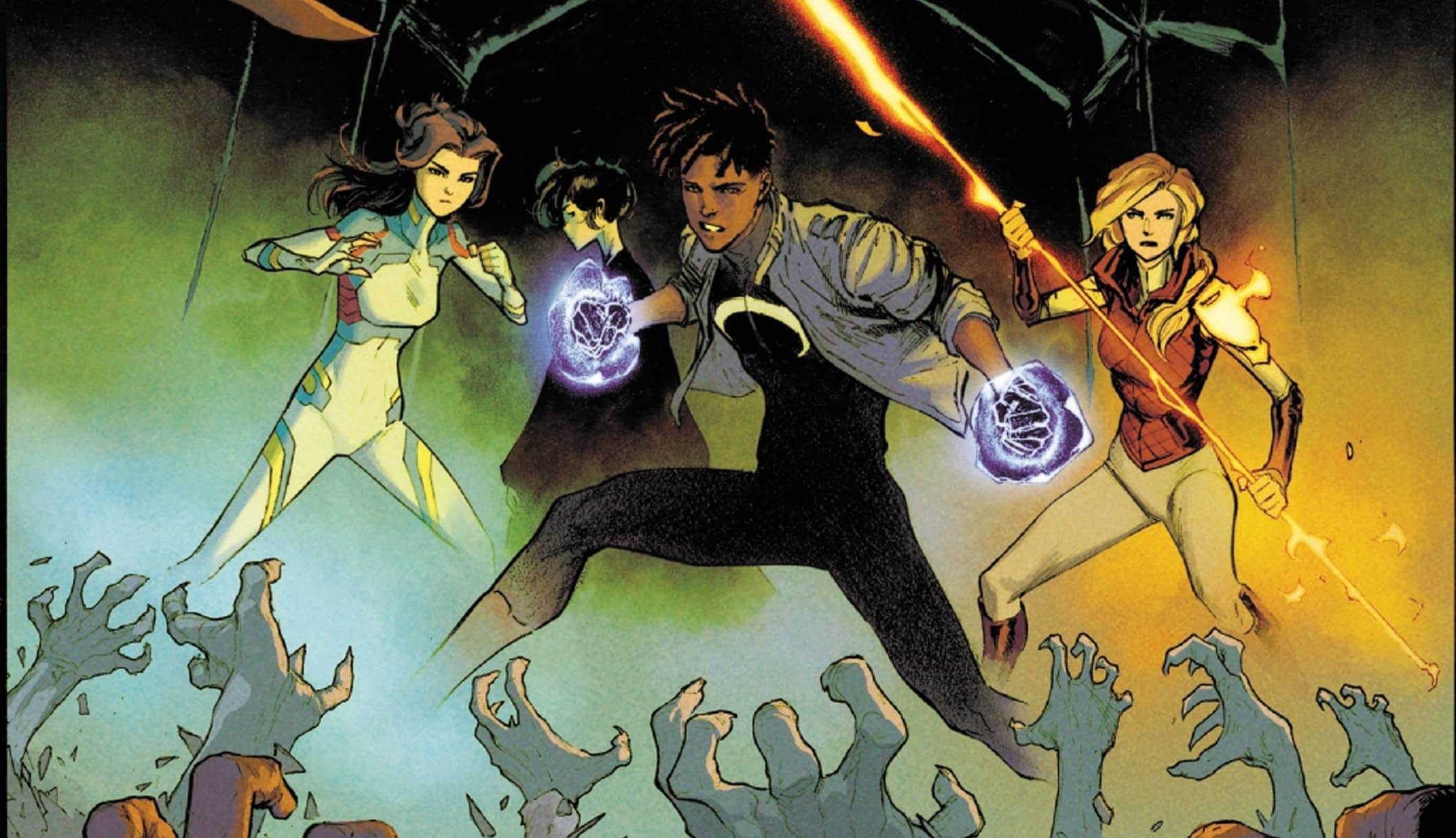Bobby Drake’s visiting Kitty Pryde in Chicago — but is it really him? Teen mutant Trista Marshall’s trying out for the high school musical — but is it right for her? Kitty and Emma keep training their new team — but can they keep it up? Find out in the bundle of transitions that is Exceptional X-Men #4, written by Eve Ewing, drawn by Carmen Carnero, colored by Nolan Woodard and lettered by Travis Lanham.
The first-ever Kitty Pryde stories (look them up!) relied on a fish-out-of-water trope: a would-be normie girl, albeit with “genius-level intellect,” thrust into a Hellfire Club-meets-Dark Phoenix situation, unlearning her suburbs’ reflexes and picking up superhero habits instead. She had to become, way too early and with plenty of backward looks, almost the same kind of hero Cyclops had to be. She’s been that kind of hero, off and on, for at least 10 years in her universe, and something like 40 in ours. And after each especially violent or horrifying experience on an X-team, she tries to get off that carousel, to lead another version of a genius-level intellect’s normal-seeming Chicagoland life.
Of course, other heroes, or villains, or her own sense of responsibility to other mutants, keep dragging her back. That’s where Eve Ewing started this Kate-centered title, whose character beats, thoughtful dialogue and never-excessive combat scenes would make its four issues a standout in any X-era, let alone this one (because this one’s a mess). And, because Ewing knows her Kate Pryde history, this particular version of the carousel comes with a new psychological aspect: Kate’s resentments, reflexes and (say it with me) trauma from her recent superheroing make her very questionably fit for civilian life.
That life looked tough to sustain the last three times she quit and moved back to Chicago (see Mekanix, or 2017’s X-Men Prime). This time it’s worse, because the life she’s jettisoned ended up less heroic than antiheroic, less hero-with-ninja-skills than kill-like-a-ninja. Shadowkat, the small-a avenger and sometime assassin from the Fall of X era, represented a new personality and costume (and spelling) for the Kate who’s always been a good girl, a figure for reader identification and (even in her Red Queen Pirate era) mostly the conscience of the team. How bad will her Shadowkat hangover be? Will she get out of it this time? Will her (apparently) girlfriend stand for it?
Before Ewing reaches those questions, she, and Carnero and Woodard give us a beautiful, self-contained YA subplot. Trista, whose powers involve metallic armor and stretchy tendrils, doesn’t especially want to be strong, or brave, or self-reliant in the way that her mentors and teachers (Emma Frost included) ask. Instead she wants to court a cute guy and make it on stage as the lead in the next school play. These opening high school panels speak to stereotypes about Black girls and women (for more thoughts on those, see Ewing’s fine Ironheart run). They look great, especially when Carnero gets to draw close-ups on Trista’s happy, worried, skeptical, overwhelmed or ambivalent face. And they give us a fun fight against a monster of the week, a giant, puke-green tardigrade-ish thing with teeth that literally leapt into Chicago from the most recent issue of X-Force. I’ll save you the mini-spoilers while letting you know that for Trista, things turn out OK.
For Kitty? It’s complicated. Bobby Drake, former jokester (no jokes here, though), complicated ex-boyfriend and emissary from no one knows where, has popped into Chicago to say hi and help train the teens. “Of course. My old friend Bobby. In my house. With no notice.” One Carnero panel shows Bobby’s affectionate-in-public joshing, Kitty’s notable discomfort and both of their shoulders, touching, trying to hide the awkward from Kitty’s new friends. She does not want him there. She does not want to go back to the X-Men. She wants a new life, with (or without) training mutant teens on the side. And she’s running from something harsher than the adventures she had in her teens: During the Fall of X, she became Shadowkat, Krakoa’s violent revenger. She killed people, just like Logan and Laura do — just what she once refused to do. She let her anger rule. And she wants to be done with that, even though (or maybe because) it’s given her sharper-than-ever eyes for deception.

What’s Bobby really doing in Chicago? Who’s he texting when he steps out of view every so often, clutching his phone? Is that really Bobby, anyway? In heart, mind and body? Wouldn’t be the first time he wasn’t himself. Especially not in the presence of Emma Frost.
“You can say I’m running away,” Kitty tells Bobby (or is it Bobby?). “But I’m choosing this. I’m choosing these kids. Choosing to be the teacher I wish I had.” Rather than being like Professor Xavier, the teacher she had. Who was, as we all know by now, a jerk. Again, the writing’s good enough that I’ll eschew spoilers, but I will say that the answer Kitty gets from her houseguest shows how her suspicions got honed by her Shadowkat days. It also shows how hard it’s gonna be for her to ever even attempt to keep up a normal life, with normal roommates.
“After the first death, there is no other,” wrote Dylan Thomas, the famous Welsh mutant. Once her new roommate and maybe-girlfriend find out about Shadowkat, can Kitty ever go back to her younger self?
Also, can Carnero draw Kitty forever? Look at the faces on that last full-page spread. Starting with Kitty, then Emma (appalled, but bemused), then Trista (hands over face, horrified). Comics are a visual medium, but at their peak they’re about people and how people feel. Carnero’s better at her face and her body language than anyone since (at least) Chris Bachalo in the Brian Michael Bendis era, and Carnero (like Ewing) takes a lot more interest in how civilians look, in how Kitty looks interacting with them, in the kinds of angles and compositions and even clothing that you’d see in a comic about non-powered lives. More like this, please. And more teen mutants’ tales.
Points of Pryde
- Trista’s pre-monster-attack audition involves a monologue from Lorraine Hansberry’s play Raisin in the Sun. The school play itself, called The Loveliest Sunday, has a lead named Violetta, a headstrong sister named Florence and a housemaid named Mary Ann. Is it real?
- Bobby wears a UCLA T-shirt in correct blue and yellow Bruins colors, but what do the black and white vertical stripes on Kate Pryde’s T-shirt mean? It’s not the band Black Flag, and it’s not the MIT Press.
- Trista narrates half this issue. Can we look forward to narration from Ewing’s other teens?
Buy Exceptional X-Men #4 here. (Disclaimer: As an Amazon Associate, ComicsXF may earn from qualifying purchases.)
Stephanie Burt is Professor of English at Harvard. Her podcast about superhero role playing games is Team-Up Moves, with Fiona Hopkins; her latest book of poems is We Are Mermaids. Her nose still hurts from that thing with the gate.






